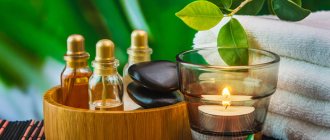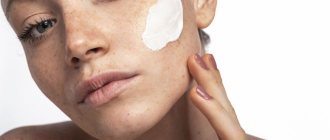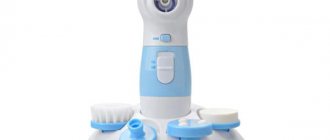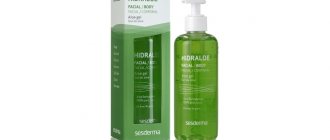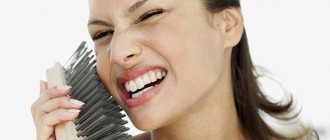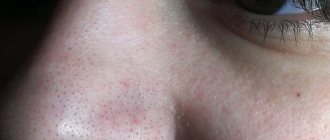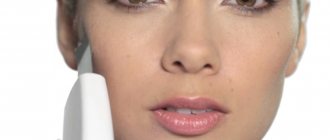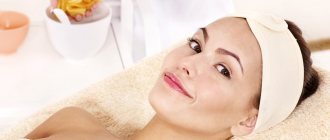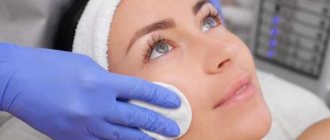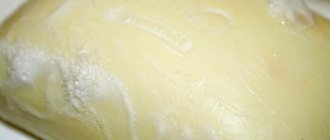In the article “Ultrasonic cleaning of the face, or your pockets?” I told you that ultrasound cleaning, unfortunately, does not remove dense, deep-seated comedones. Such contaminants can only be removed using mechanical or combined cleaning.
- What is mechanical facial cleansing
- Combined facial cleansing
7 popular misconceptions about mechanical facial cleansing
- Mechanical cleaning should be done regularly
- Remove many comedones at once
- Removing inflamed acne
- Steaming your face before cleansing
- Cleaning on the eve of critical days
- Red spots after facial cleansing
- There is no need for facial cleansing at all
I recorded a video for you about mechanical facial cleansing:
When should you resort to salon cleaning?
Let's figure out whether you need to do facial cleansing. Regular deep cleansing is necessary for any type of dermis. But for some, homemade scrubs and masks are enough, while others need a set of procedures from a cosmetologist.
Those with normal epidermis are the luckiest ones - their sebaceous glands do not produce excessive amounts of sebum. This means that self-care is enough to maintain the health and beauty of your skin.
Girls with dry skin are least likely to suffer from blackheads or pimples. Soft peelings or gomas can gently exfoliate dead skin cells of the epidermis. These can be either store-bought products or specially selected professional ones.
Combination or oily skin more often than other types needs deep cleansing of pores. Its owners are regularly bothered by blackheads or comedones. They are the ones who need and can do facial cleansing regularly.
It is better to contact a cosmetologist right away, rather than wait until the problem gets worse. Then it will take fewer sessions to solve it.
Indications for use
Proper skin care is the key to its health, youth and beauty. The standard is an even, smooth face with a uniform shade, without wrinkles, pigmentation and congestion spots, pimples, blackheads and other defects.
Many women strive for this. But at home it is not always possible to achieve the desired effect, especially for those with problematic epidermis. Scrubs, peels and other products clean only the outer layer of the skin.
Professional cleansing will help improve the condition of the dermis, which affects the deep layers of the skin and is useful because it works in several directions:
- regulates the separation of sebaceous secretions;
- eliminates oily shine;
- fights blackheads, acne, pimples, milia (a type of wen);
- lightens pigmentation;
- evens out skin tone;
- eliminates post-acne, scars, scars;
- smoothes wrinkles;
- eliminates dryness and flaking of the skin.
One of the few problems that cannot be dealt with using this method is the elimination of wen, which is a lipoma or atheroma (benign formation). To eliminate subcutaneous lumps, the doctor will recommend laser correction or another option. In all other cases, the doctor will prescribe a certain type of cleaning, taking into account the type of skin and the problems that need to be solved.
Typically, experts do not recommend cleaning the epidermis using salon methods until you reach adulthood. It’s even better to postpone the procedure until age 25–30, when dermal regeneration slows down. In adolescence, it is worth using a gentle alternative: masks, special cosmetics for young skin.
Attention! Many doctors are confident that early intervention in the natural processes of self-renewal of the skin is harmful and is fraught in the future with early wrinkles, dry epidermis and other troubles.
Difference between home and professional cleaning
You can cleanse the pores yourself using preliminary steaming, peelings, scrubs, and masks. For skin without any special problems, this is enough.
But with frequent sebaceous plugs, blackheads, and inflammation, home care does not always give 100% results. Because it is difficult to deeply cleanse the pores. It is impossible to completely remove makeup residues, sebum, and other contaminants from them.
In terms of their effectiveness, store-bought masks, scrubs, and peelings are inferior to hardware cosmetology or professional products. Homemade beauty recipes also cannot always radically change the situation. And their incorrect use can cause harm.
Facial cleansing by a cosmetologist is necessary for problem skin. It allows you to deeply cleanse the pores; professional cosmetics that are used after it effectively narrow them. Many procedures have a complex effect on the skin, improving its firmness and elasticity.
Mechanical cleaning - squeezing out comedones - can only be entrusted to a cosmetologist. Opening pimples on your own leads to the spread of infection throughout the face. After inflammation, scars or red marks remain.
Mechanical cleaning
First, the skin is steamed with special gels to open the pores and enhance the secretion of the sebaceous glands. After this, the cosmetologist removes impurities from the skin. Then treatment is carried out, the purpose of which is to prevent inflammatory processes. A mask that tightens the pores is applied to the skin. At the end of the procedure, a soothing cream should be applied.
- Pros: The procedure is the most common, and the cleaning is the most thorough. During it, deep treatment of the skin is carried out, the result is visible immediately, all sensations are controlled, the instruments are sterile.
- “Cons”: Mechanical cleansing is recognized as the most harsh and traumatic for the skin, and is very painful. During the day, swelling and inflammation may remain on the face. Mechanical cleaning cannot be carried out in the presence of ulcers and inflammation.
Wanting to save money, some women, especially young girls, try to remove acne at home on their own. This is absolutely not to be desired: the required sterility is impossible, and the result may well be a significant deterioration in appearance.
Types of procedures
Beauty salons offer a large number of cleaning services. Whether they bring benefit or harm to the skin of the face depends on how correctly it is selected. Sensitive or thin skin should not be injured; a combined method or peelings are used for it.
Mechanical
The most common method is mechanical (manual) cleaning. With its help, sebaceous plugs, formed comedones, and blackheads are removed. It is carried out in several stages:
- Opening of pores. Special masks are used for this. You should refuse manipulation if the salon offers you to steam your face in front of it. This is an outdated method.
- Direct acne removal. To do this, the treated area of skin is disinfected. Using a special tool (Una spoon, Vidal loop), comedones or blackheads are squeezed out.
- Applying an anti-inflammatory, pore-tightening mask.
Mechanical cleansing of the face will be beneficial if a small area is treated at once; in advanced cases, complete removal of acne will cause more harm. The procedure should be abandoned altogether during menstrual periods, with severe purulent inflammation.
Vacuum
A gentle alternative to mechanical cleaning. A special device “pulls out” the remaining sebum and other impurities from the pores. Acne and comedones are also removed. At the same time, a kind of lymphatic drainage massage is performed that improves complexion.
It should not be used by those with dry, thin dermis, girls and women whose blood vessels are too close to the surface. The result after it will be noticeable the next day.
Ultrasonic
The procedure is performed using a special ultrasound machine. Ultrasonic waves gently exfoliate dead cells and remove impurities. They also massage and smooth out fine wrinkles.
Cleaning is painless, there is no redness or swelling after it. Compared to other types of cleaning, it takes longer.
The procedure is contraindicated in case of exacerbation of inflammation on the face, pregnancy, or after mesotherapy.
Chemical
For cleansing, special enzymes are used: papain, bromelain or organic acids (glycolic, lactic and others). First, a pore-opening composition is applied to the face, then a means to dissolve the keratinized epithelium and remove residual sebum. Then soothing masks are applied.
Cleaning is contraindicated for wounds, herpes, and keloid scars.
Galvanic
It is carried out using a special apparatus with electrodes. An alkaline solution is applied to the face, then a small current is applied using electrodes. As a result, the liquid penetrates the pores and dissolves contaminants.
As a result of such cleaning, the elasticity of the integument increases and the walls of the capillaries are strengthened. And with regular use, sebum production decreases.
Combined
This type of cleaning combines the use of ultrasound and mechanical or vacuum techniques. It is more gentle and suitable for girls and women with thin, sensitive skin.
The cosmetologist, depending on the condition of the skin, chooses on which areas which type to use. This minimizes skin trauma, redness, and swelling.
Ultrasonic cleaning
It uses a device that applies ultrasonic waves to the skin. They perfectly exfoliate old layers, remove impurities and comedones. Particularly effective for oily and aging skin.
- “Pros”: the cleaning is softer, the skin is not injured. Only dead cells are removed, leaving young and healthy ones. During cleaning, the tissues are regenerated, the skin seems to glow from the inside, looks renewed and rested. Ultrasonic waves help smooth out fine wrinkles by massaging the skin. No pre-steaming is necessary. There will be no inflammation or redness after cleaning. The procedure is completely painless.
- “Cons”: inflammatory and infectious processes in acute stages, facelifts and pregnancy exclude the procedure. Cleaning is superficial, and it is better to carry it out as a preventive measure or in combination with other types.
What results does salon cleaning give?
Deeply cleansed pores, getting rid of blackheads, comedones and blackheads are the undeniable advantages of professional procedures. For girls whose skin is prone to inflammation, it is useful to have regular facial cleansing from cosmetologists not only to get rid of skin problems, but also to prevent them.
What do salon cleansing procedures provide:
- Significant improvement in skin condition - getting rid of inflammation.
- Increasing skin firmness and elasticity (ultrasonic, vacuum, galvanic, chemical).
- Evens out complexion by narrowing pores and exfoliating effect.
- Normalization of sebum production (ultrasonic, galvanic, chemical).
- Increased sensitivity of the epidermis to masks, creams, medicinal ointments.
It is important to follow the cosmetologist’s recommendations on preparation for the procedure and after. It is dangerous to overuse facial cleansing, especially mechanical cleansing. Always choose a specialist and salon carefully.
Is facial cleansing harmful?
Experts still disagree on whether facial cleansing is harmful. If we talk about mechanical, it should be carried out according to objective indications, only by a competent cosmetologist. This type of reading should not be abused, as the pores “stretch” due to regular mechanical influences. You also need to be more careful with this procedure after 30-35 years, since with age the pores become wider.
The safest are ultrasonic, galvanic, and combined. But you don’t need to resort to them every month, but carry them out only according to indications. Thus, too frequent galvanic procedures, instead of reducing sebum production, will increase it.
Efficiency of the procedure
With the help of cleansing, it will be possible to effectively exfoliate the outer layer of the skin, which will be replaced by a new epidermis: soft, smooth, more elastic and fresh.
The procedure will help even out the skin tone and texture, restore pH, cleanse the dermis of impurities and toxins, improve metabolism, accelerate blood circulation, activate regeneration and launch the production of collagen and elastin.
Cleansing will be effective for women who want to slightly rejuvenate their skin and rid it of various defects: age spots, wrinkles, acne and post-acne, comedones, and reduce the appearance of pores.
The frequency and number of sessions depend on the specific method, the complexity of the tasks, the age of the patient, as well as her skin type. Those with dry and normal dermis can go to the salon once every 4-6 months. For girls with oily, combination, problem skin, the cosmetologist will offer more frequent visits - approximately every 1.5-2 months. Usually, to obtain a noticeable result, a course of 3 to 5–6 procedures is required.
Doctors advise cleaning during periods of no active sun: late autumn, winter, early spring. The renewed epidermis is exposed to ultraviolet radiation, which is expressed in pigmentation of the treated areas. At the same time, regardless of the time of the procedure, the skin should be protected with cosmetics with SPF.
How often can you clean?
How often can you resort to professional cleansing and facial cleansing? It depends on its type.
Cosmetologists recommend:
- Resort to mechanical (manual) cleaning twice a year.
- Ultrasound – for the prevention of comedones and blackheads or for minor problems is done once every three months. For problem skin – every 1.5 times.
- Vacuum - will be effective and will not harm the skin if done two or three times a year.
- Chemical – 1 time per month.
Important information about facial cleansing is presented in the video:
Dry cleaning
Masks and peelings with organic acids are used for this. There are enzymatic and drug cleanings. For the latter, the cosmetologist uses products with acids, and for enzymatic - with enzymes, papain and bromelain. There is no physical effect on the skin: the cosmetologist first applies a cleansing composition to the face, then a more “caustic” mixture. As a result, the skin warms up, becomes softer, and fat cores are partially dissolved. At the end of the procedure, a soft soothing mask is applied.
- “Pros”: cleansing is effective for removing acne, can be carried out for skin inflammation, but subject to the rules.
- “Cons”: traumatic for the skin.
The frequency of cleansing depends on the health of the skin. For heavily soiled and oily skin, the procedure is recommended at least once every ten days; for normal skin, once or twice a month is sufficient.
Depending on the sensitivity of the skin, it is worth choosing the type of cleansing. The more delicate the skin, the more careful treatment it requires. The most effective cleaning is complex: a combination of chemical with vacuum, mechanical or ultrasonic.
Any cleansing should combine makeup removal, pore enlargement, softening of comedones, cleansing itself, massage with the application of a soothing mask and cream. Only with such a package of services will the question not arise once again whether it is necessary to do facial cleansing at all.
- +0
- -1
- 1 rating
1 ratingX
| Like! | Dislike! |
| 0% | 100% |
1/51

